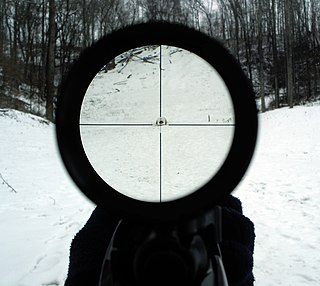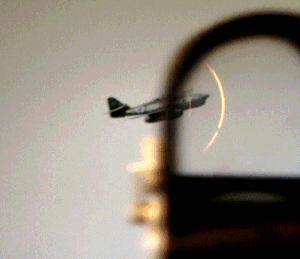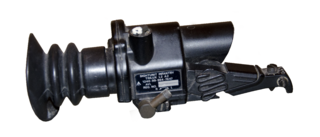The Colt Canada C7 and C8 are a Canadian family of service rifles, manufactured by Colt Canada, having similar design and function to the Colt M16A3.

The FN P90 is a submachine gun chambered for the 5.7×28mm cartridge, also classified as a personal defense weapon, designed and manufactured by FN Herstal in Belgium. Created in response to NATO requests for a replacement for 9×19mm Parabellum firearms, the P90 was designed as a compact but powerful firearm for vehicle crews, operators of crew-served weapons, support personnel, special forces, and counter-terrorist groups.
The M60, officially the Machine Gun, Caliber 7.62 mm, M60, is a family of American general-purpose machine guns firing 7.62×51mm NATO cartridges from a disintegrating belt of M13 links. There are several types of ammunition approved for use in the M60, including ball, tracer, and armor-piercing rounds.

The Advanced Combat Optical Gunsight (ACOG) is a series of prismatic telescopic sights manufactured by Trijicon. The ACOG was originally designed to be used on the M16 rifle and M4 carbine, but Trijicon has also developed ACOG accessories for other firearms. Models provide fixed-power magnification levels from 1.25× to 6×. ACOG reticles are illuminated at night by an internal tritium phosphor. Some versions have an additional daytime reticle illumination via a passive external fiberoptic light pipe or are LED-illuminated using a dry battery. The first ACOG model, known as the TA01, was released in 1987.

A telescopic sight, commonly called a scope informally, is an optical sighting device based on a refracting telescope. It is equipped with some form of a referencing pattern – known as a reticle – mounted in a focally appropriate position in its optical system to provide an accurate point of aim. Telescopic sights are used with all types of systems that require magnification in addition to reliable visual aiming, as opposed to non-magnifying iron sights, reflector (reflex) sights, holographic sights or laser sights, and are most commonly found on long-barrel firearms, particularly rifles, usually via a scope mount. Similar devices are also found on other platforms such as Artillery, Tanks and even Aircraft. The optical components may be combined with optoelectronics to add night vision or smart device features.
The Ak 5 is a license-built Swedish version of the Belgian FN FNC assault rifle, with certain modifications, mostly to adapt the weapon to the partially subarctic Swedish climate. The Ak 5 is the current service rifle of the Swedish Armed Forces, adopted in 1986, replacing the Ak 4, a license-built version of the Heckler & Koch G3.

The Sight Unit Small Arms, Trilux, or SUSAT, is a 4× telescopic sight, with tritium-powered illumination utilised at dusk or dawn. The full name of the current model is the SUSAT L9A1. The sight is not designed as a sniper sight, but is rather intended to be mounted on a variety of rifles and to be used by all infantrymen. A similar device is the Advanced Combat Optical Gunsight (ACOG).

The MG 3 is a German general-purpose machine gun chambered for the 7.62×51mm NATO cartridge. The weapon's design is derived from the World War II era MG 42 that fired the 7.92×57mm Mauser round.

A milliradian is an SI derived unit for angular measurement which is defined as a thousandth of a radian (0.001 radian). Milliradians are used in adjustment of firearm sights by adjusting the angle of the sight compared to the barrel. Milliradians are also used for comparing shot groupings, or to compare the difficulty of hitting different sized shooting targets at different distances. When using a scope with both mrad adjustment and a reticle with mrad markings, the shooter can use the reticle as a ruler to count the number of mrads a shot was off-target, which directly translates to the sight adjustment needed to hit the target with a follow-up shot. Optics with mrad markings in the reticle can also be used to make a range estimation of a known size target, or vice versa, to determine a target size if the distance is known, a practice called "milling".
Aimpoint AB is a Swedish optics company based in Malmö, Sweden that manufactures red dot sights.

Trijicon, Inc. is an American manufacturing company based in Wixom, Michigan that designs and distributes sighting devices for firearms including pistols, rifles and shotguns. Trijicon specializes in self-luminous optics and night sights, mainly using the low-energy tritium illumination, light-gathering fiber optics and battery-powered LED.

EOTECH is an American company that designs, manufactures, and markets electro-optic and night vision products and systems. The company is headquartered in Plymouth, Michigan. They produce holographic weapon sights for small arms that have been adopted by various military and law enforcement agencies as close quarters battle firearm sights.

The C79 Optical sight is a small arms telescopic sight. Elcan names it as the SpecterOS3.4x, but in Canadian service, it is typically referred to as the C79 or the C79A2. A variant, the M145 Machine Gun Optic is in use by the US military. It is 3.4×28, meaning 3.4x magnification, and a 28mm diameter objective lens. A tritium illuminated reticle provides for normal and low-light conditions sighting. It can be mounted to a variety of rifles and light machine guns using the M1913 Picatinny rail mounting system or the similar "Diemaco" rail system found on small arms produced by Diemaco/Colt Canada. It is manufactured by Elcan and can be found on military service weapons around the world. Similar rifle sights are the Sight Unit Small Arms, Trilux (SUSAT) and the Advanced Combat Optical Gunsight (ACOG).

The PSO-1 is a 4×24 telescopic sight manufactured in Russia by the Novosibirsk instrument-making factory and issued with the Russian military Dragunov sniper rifle. It was introduced on 3 July 1963 together with the Dragunov sniper rifle.

AN/PVS-4 is the U.S. military designation for a specification of the first second generation passive Night vision device.

A red dot sight is a common classification for a non-magnifying reflector sight that provides an illuminated red dot to the user as a point of aim. A standard design uses a red light-emitting diode (LED) at the focus of collimating optics, which generates a dot-style illuminated reticle that stays in alignment with the weapon the sight is attached to, regardless of eye position.

A reflector sight or reflex sight is an optical sight that allows the user to look through a partially reflecting glass element and see an illuminated projection of an aiming point or some other image superimposed on the field of view. These sights work on the simple optical principle that anything at the focus of a lens or curved mirror will appear to be sitting in front of the viewer at infinity. Reflector sights employ some sort of "reflector" to allow the viewer to see the infinity image and the field of view at the same time, either by bouncing the image created by lens off a slanted glass plate, or by using a mostly clear curved glass reflector that images the reticle while the viewer looks through the reflector. Since the reticle is at infinity it stays in alignment with the device to which the sight is attached regardless of the viewer's eye position, removing most of the parallax and other sighting errors found in simple sighting devices.

The SUIT sight is a 4× prism sight with tritium-powered illumination, utilised at dusk or dawn. The full name is the L2A2 Sight Unit Infantry Trilux. The sight is not designed as a sniper sight, but as a standard issue infantry sight to improve the infantryman's night fighting capability and to assist target identification at long range in daylight and in poor light conditions.

A prism sight or prismatic sight, sometimes also called prism scope or prismatic scope, is a type telescopic sight which uses a reflective prism for its image-erecting system, instead of the series of relay lenses found in traditional telescopic sights. The use of prisms makes it possible to construct a shorter and lighter sight, or with an offset between the eyepiece and objective axes.

The Elcan Specter is a line of multi-role prism sights created by Raytheon ELCAN Optical Technologies originally designed for M16/M4 family of rifles but now also exists for light machine gun and heavy machineguns. Most of the optics are capable of switching between magnifications and illumination.














